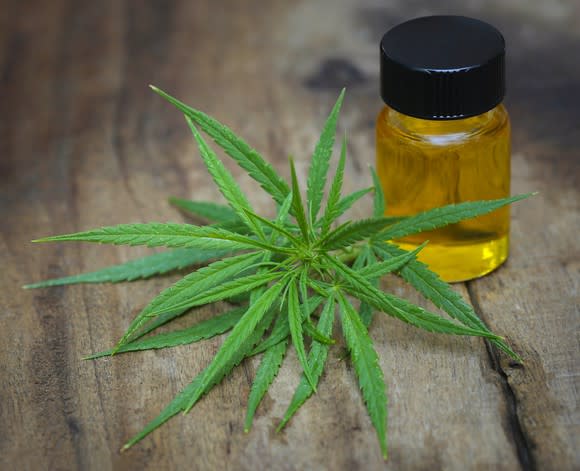The Cheapest Pot Stock Based on Forward Price-to-Sales
Legal cannabis is arguably the fastest and most consistently growing industry in North America. Cannabis research firm ArcView has estimated an annual growth rate of 28% in North America through 2021, while a report from New Frontier Data that specifically focused on the U.S. found that legalization could lead to an estimated 1.1 million new jobs being created -- both directly and indirectly tied to the pot industry -- by 2025. It has businesses and investors seeing green.
Marijuana is also a drug that has growing public support. National pollster Gallup found that nearly two-thirds of Americans in its October 2017 survey are now in favor of legalization. That's up from just 25% in 1995, the year before California became the first state to OK the use of medical marijuana for compassionate use patients.

Image source: Getty Images.
Investors have further reason to be excited because of the expected legalization of recreational weed in Canada by this summer. With legalization looking likely, and a two-year tax-sharing agreement in place with all but one province (Manitoba), Canada could add more than $5 billion in annual sales to this rapidly growing industry.
On paper, it looks like the marijuana industry is budding. But dig a bit deeper and you'll find that no two pot stocks are remotely alike. Sure, they may all be trying to expand their production capacity, forge deals, and innovate, but some have premiums that are truly sky-high.
Pining for value in the marijuana industry
Though there are no concrete fundamental measures that definitively make one marijuana stock a "value" relative to its peers, the price-to-sales ratio, which takes into account a company's market cap relative to its annual (or trailing 12-month annual) revenue, is one piece of the puzzle that's often useful. Of course, most pot stocks don't have much in the way of revenue, so the trailing 12-month price-to-sales ratio is pretty useless at the moment. But, if we were to examine a forward price-to-sales ratio -- i.e., current market cap divided by consensus sales for 2019 -- we could get a clearer picture of which pot stocks are "cheaper" than their peers.

Image source: Getty Images.
With this in mind, here's a quick glimpse of what the forward price-to-sales ratios look like for some of the biggest pot stocks (through April 9).
Canopy Growth Corp.: 15.2
Aurora Cannabis: 13.2
Aphria: 11.6
MedReleaf: 10.6
OrganiGram Holdings (NASDAQOTH: OGRMF): 4.1
GW Pharmaceuticals: 18
Cronos Group: 28.9
With the exception of GW Pharmaceuticals, which is a cannabinoid-based drug developer, these are all Canadian-based growers or investment companies in growers.
What immediately stands out is just how expensive Cronos Group is relative to its sales potential and its peers. Cronos received quite the boost by becoming the first weed stock to uplist from the over-the-counter exchange to the Nasdaq earlier this year. However, it doesn't appear that the company's ownership in three core assets is going to generate nearly enough in sales, at least by 2019, to offset its apparently bloated market cap.
By comparison, OrganiGram Holdings looks like a potential steal of a deal among marijuana stocks.

Image source: Getty Images.
Why OrganiGram Holdings could be the cheapest pot stock of the bunch
It has become an almost common occurrence for OrganiGram to be listed as one of the cheapest marijuana stocks based on a plethora of metrics. There are a few factors that really stand out and make it a pot stock worthy of investor consideration.
For starters, while most growers have been expanding production in a variety of locations, OrganiGram has chosen to centralize its growing at its Moncton facility in New Brunswick. Keeping all of its growing activity at one facility is an easy way to control and reduce its growing costs, which could give it some of the best margins in the industry on dried cannabis.
Second, OrganiGram just blew its previous annual production estimates out of the water. A recent update noted that crop yield has been significantly higher than expected, resulting in the company upping its annual forecast from 65,000 kilograms a year to 113,000 kilograms annually. Though production forecasts have proven fluid, OrganiGram is likely to be somewhere between the fifth- and seventh-largest producer in Canada, based on its annual production estimate.
The company is also focused on higher margin cannabis oils rather than highly commoditized dried cannabis. In its fiscal first quarter, OrganiGram sold 419,000 ml of cannabis oil, up from 178,000 ml in the sequential quarter, and well over the 77,000 ml it sold in Q1 2017. Oils are a niche product that bears a higher price point and a much beefier margin.

Image source: Getty Images.
There are concerns, too
So, why doesn't OrganiGram get any respect? Probably the biggest issue is that its capacity expansion won't be complete until April 2020. Even though it remains on track to be a major player in Canada, most of its peers' expansion projects will be complete in 2018 or 2019. This might allow its peers the opportunity to forge long-term supply deals or engage consumers with proprietary cannabis brands long before OrganiGram is able to do so itself.
Another concern is capacity expansion. A number of estimates suggest that Canada is expected to demand around 800,000 kilograms of dried cannabis each year. However, production forecasts imply that Canadian growers might produce as much as 2 million kilograms of cannabis per year by 2020. What on Earth happens to this oversupply? Some of it is expected to be exported to markets where medicinal marijuana is legal. What's unclear is if there's enough demand to completely offset domestic supply.
Finally, it's worth pointing out (once more) that the price-to-sales ratio is just one of many puzzle pieces that investors should consider. It's not a perfect measure of value. While OrganiGram is inexpensive based on this and a number of other metrics, it has also been funding its expansion with bought-deal offerings, resulting in shareholder dilution. This is something that prospective investors in OrganiGram, and practically every publicly traded Canadian grower, would have to consider.
More From The Motley Fool
Sean Williams has no position in any of the stocks mentioned. The Motley Fool recommends Nasdaq. The Motley Fool has a disclosure policy.
